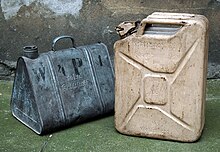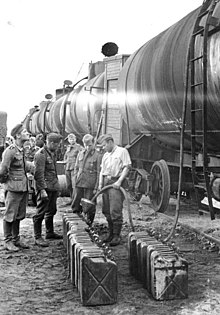Wehrmacht standard canister

The Wehrmacht standard canister is a canister with a capacity of 20 liters . It was developed in the mid-1930s for the German Wehrmacht and was to be found in almost all European and North African theaters of the Second World War . The containers are still manufactured in large numbers in many countries today. The Wehrmacht standard canister is considered to be the classic gasoline canister. In English-speaking countries is called the canister also jerrycan of jerry as a slang term for German ( German ).
history
Up to the development of the standard canister, handy triangular fuel tanks made of embossed sheet metal with a capacity between 2.5 and 20 liters were common in civil and military use.
The Wehrmacht standard canister is also made of deep-drawn sheet metal and was developed after a tender 1935/36 by the company Eisenwerk Müller & Co. AG in Schwelm, Westphalia, under the direction of Vinzenz Grünvogel. In 1936 a series of 5,000 units was sent to the troops for testing. The official introduction took place with the General Army Communication (AHM) No. 324 of July 8, 1937.
In 1937 it received its final form from the Ambi-Budd company (ABP, Ambi-Budd Presswerk Berlin). Switzerland and Italy also used these standard canisters as early as the Second World War. The British War Department also had identical canisters imported for the British Army . When the Allies landed in July 1944, huge quantities of these canisters reached mainland Europe.
execution
The original model had a simple, cross-shaped bead on both sides to reinforce the sheet metal and was manufactured until around 1941. The model with an improved profile was produced in large quantities for the Wehrmacht and Waffen-SS from 1939 to 1945 by 19 manufacturers. From 1940 there was also a standard container for 20 liters of water.
The standard canister allowed the vehicles to be refueled without the additional use of tools or funnels.
Markings
In addition to information on the manufacturer of the respective canister, the standard canisters bear the following imprints:
- 20 l fuel or 20 l water
- Flammable (only with fuel)
- Year of manufacture
- Manufacturer
- its German production number (example: rhs for Rheinmetall-Borsig AG, Sömmerda )
- Owner (e.g. army , armed forces , SS )
The British canisters were given the abbreviation W ↑ D (for the British W ar D epartment , with the so-called Broad arrow ) as an identifier, they are colloquially called Jerrycan . Although the British gave these canisters to the USA, other fuel tanks were produced there.
Standard canisters manufactured in the GDR bear the TGL mark .
Reproductions and copies or forgeries
The original Wehrmacht standard canisters, popular with collectors and in classic car circles, are still occasionally available today and some are in use. With regard to the sales prices achieved, replicas are offered as originals and real forgeries are also made.
gallery
September 1958, maneuvers by the Bundeswehr, refueling an M42 Duster anti-aircraft tank with a 40 mm twin cannon and canister




